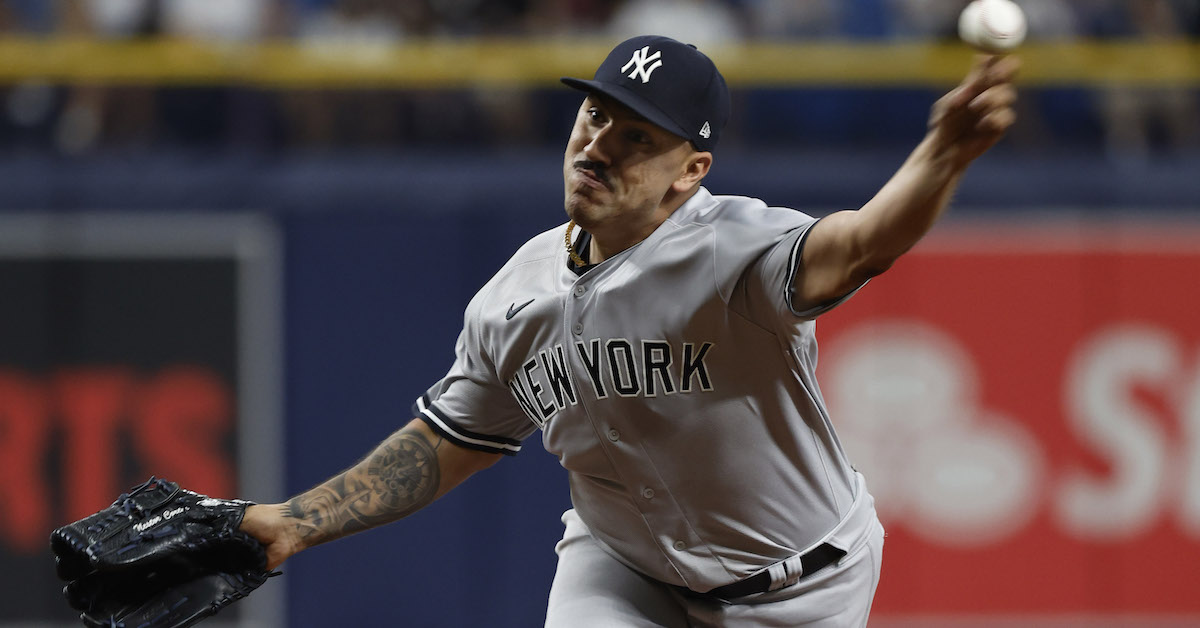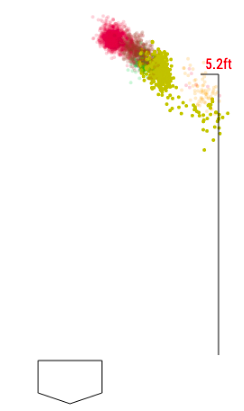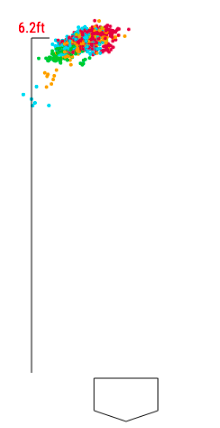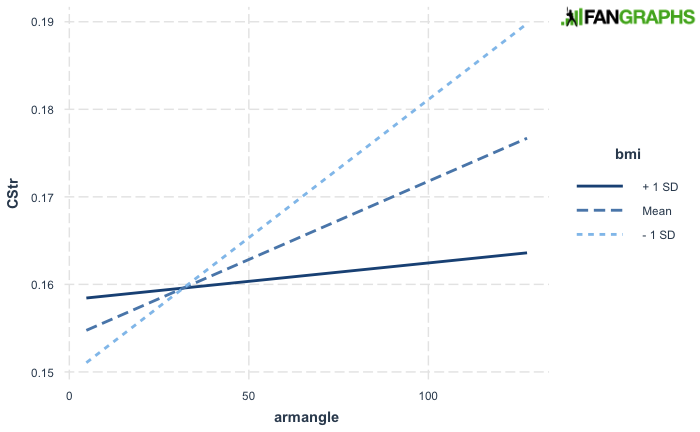[ad_1]

Initially a Thirty sixth-round choose within the 2013 draft by the Yankees, Nestor Cortes frolicked with the Orioles and Mariners earlier than returning to the Bronx and placing all of it collectively towards the top of the 2021 season, his age-26 12 months. Even upon breaking out, he was dubbed an “everyman” by the New York Submit, ignored by scouts as a result of he didn’t stand as tall as different hurlers and since he lacked overpowering velocity. But in 2022, Cortes mowed hitters all the way down to the tune of a 2.44 ERA and 20.3% Okay-BB price. Removed from an everyman, he was a standout athlete.
The southpaw’s breakout wasn’t a product of a mid-career development spurt. If something, his emergence got here regardless of his 5-foot-11 peak; his 159 ERA+ in 2022 tied him for the Twenty seventh-best mark amongst sub-six-foot hurlers because the Reside Ball period started in 1920. Fairly, essentially the most concrete causes for Cortes’ enhancements embody a velocity leap in each 2021 and ’22 (although his velo remains to be under common) and the introduction of a cutter paired with a revamped slider. But regardless of the ambiguous affect it has on his sport, what maybe differentiates Cortes essentially the most from different pitchers is his strategy on the mound, together with however not restricted to his various arm angles.
The hurler’s drop-down strikes have been the topic of many an article, together with Lucas Kelly’s piece on this very website. The dialogue on arm angles extra broadly, nevertheless, has been quite muted, save for Logan Mottley’s (now of Fanatics, beforehand of the Texas Rangers) post describing how they are often calculated from Statcast information and Ben Palmer’s piece for Pitcher Checklist digging into the Mottley information.
Even in these articles, there isn’t a point out of how stature may play into the effectiveness of sure arm angles. As an alternative, there appears to be an implicit assumption that if one arm slot proved more practical on common (which, to be truthful, nobody has concluded), it ought to robotically be utilized extra, with out regard for what may really feel most pure for a given pitcher. What would occur if we tried to transform extra pitchers to a sidearm slot, or at the very least push them to range their arm slots a la Cortes? Utilizing Mottley’s calculations, I took a crack at these questions myself.
Why particularly a “sidearm” slot? For one, that’s the place Cortes drops all the way down to. But additionally, I discovered that for the 473 hurlers who threw at the very least 500 pitches final 12 months, extra obtuse arm angles (i.e., bigger angles created by the shoulder at launch, shifting away from overhand and towards submarine) led to considerably larger called-strike charges. Particularly, for each one-degree improve in arm angle, pitchers on common had called-strike charges 0.02% larger. As Kelly speculated in his piece, it’s potential that it’s because the rarity of a sidearm look generally offers the batter pause and so they can solely watch because the pitch zips into the strike zone. In different phrases, there might not be something intrinsic within the sidearm pitch that lends itself to the next price of referred to as strikes; if extra hurlers had been to start throwing that approach, batters may get used to it and freeze much less incessantly.
The affect on called-strike price was the one constant change based mostly on common arm angle. However even inside that discovering, pitchers who range their arm slot are inclined to have larger common arm angles than pure overhanders or three-quarter slotters, so that they could possibly be selecting up a number of the impact too; perhaps it isn’t that throwing sidearm nets extra referred to as strikes, however that mixing issues up by together with an occasional sidearm toss does. In any case, Palmer discovered that hurlers noticed jumps in pitch-level Okay-rate once they deviated from their typical arm angles on curves, knucklecurves, and/or sliders. Cortes actually falls into the latter class (his sliders are in darkish yellow):

He had two peaks in his slider arm-angle distributions: one round 60 levels (corresponding with the bigger yellow cluster) and one other round 80 (the smaller one down and to the aspect). In accordance with Palmer’s findings, Cortes’ sliders generated a a lot larger Okay-rate (33.3% out of 51 tosses versus 10.1% out of 411) when he dropped down. Nonetheless, this is likely to be because of the lefty’s tendency to drop down deeper within the depend: sliders off an arm angle better than 70 levels got here with a mean of 1.71 strikes; these off an angle lower than or equal to 70 got here with a mean of 0.59.
Regardless, I discovered that pitchers with the next bimodality (two-peak) coefficient for his or her arm-angle distributions truly didn’t see a big change in called-strike price; so as to get that change, perhaps you actually do must throw sidearm extra than simply as a change-of-pace. This remained the case once I used a measure for multimodality (a number of peaks) so as to embody a number of pitchers with trimodal distributions. Jackson Stephens was an instance of such a hurler, working the gamut from overhand to three-quarters to sidearm (albeit with few situations of the latter):

I did discover that pitchers with a bigger vary of arm angles, like Stephens, noticed considerably fewer swinging strikes but in addition allowed considerably decrease wOBAs. This implies that Stephens-esque pitchers rely extra on controlling contact high quality by means of guile quite than overpowering stuff. For his half, the right-handed reliever generated whiffs on a below-average 9.3% of his choices however allowed a .286 wOBA, 24 factors higher than league common.
But none of this solutions my unique query about stature. If we had been confronted with a pitcher in want of a mechanical tweak, it could be good to have the ability to predict how profitable a extra obtuse arm angle would show, no matter whether or not such an angle is really extra profitable for pitchers normally. Really feel is a big a part of this; if a pitcher notices discomfort or worse, ache, when attempting a brand new arm angle, that gives a straightforward reply. However for us armchair analysts, is there any approach we will prognosticate?
Whereas main league groups and coaching academies now have entry to a wealth of biomechanical information that’s in all probability higher suited to answering this query, peak and weight numbers are comparatively simple to return by for these of us again at house and symbolize a crude however possible means of study. I dug my numbers up from Baseball Reference.
To be clear, Mottley’s arm angle calculation does management for a pitcher’s peak: he derives arm angle from the triangle created by a line extending from the middle of the rubber to horizontal launch level, a line extending to vertical launch level minus 70% of a pitcher’s peak (i.e., the place the shoulder begins when the pitcher is arched over at launch), and a hypotenuse connecting these two traces. The angle between the hypotenuse and the adjusted vertical launch level aspect is arm angle. For extra on the small print of his calculation and a few savvy visuals, I like to recommend studying the piece. (And sure, he does account for pitchers who transfer round on the rubber.)
However both approach, every physique nonetheless differs by way of issues like flexibility, wingspan, and weight, elements that taking a look at heights can clue us in on. Whereas it’s simple to argue for a one-size-fits-all resolution in a 1,500-word article, the reality is, actuality isn’t that easy. Increasingly, groups and coaching amenities like Driveline are catching on, growing more and more individualized pitching plans. As an athlete, the aim is to make your physique be just right for you, using it in tandem together with your setting in accordance with the rules of ecological psychology to expend as little effort as potential and pressure your self as little as potential whereas nonetheless attaining success.
With that in thoughts, I took a take a look at how physique mass index (which elements in each peak and weight) moderated the connection between arm angle and referred to as strike price. I discovered that the upper a pitcher’s BMI, the much less their arm angle mattered when it got here to called-strike price:

Perhaps batters are inclined to view these whose our bodies don’t match that of the prototypical athlete as extra more likely to be artful; perhaps they had been influenced on this regard by pitchers like Cortes and by that New York Submit article. On condition that hitters may already be anticipating completely different seems to be from pitchers with larger BMIs, it’s potential the above end result isn’t telling us something about what sorts of pitchers are bodily restricted by way of their capacity to make the most of a number of completely different arm slots — simply that hitters may need their very own technique of guessing (subconsciously or in any other case) who will drop down.
Even when this end result was indicating one thing about bodily limitations, what issues most remains to be really feel and the extra superior biomechanical information. One of many nice issues about baseball is that gamers can are available all styles and sizes. It might be foolish to rule a pitcher out as a sidearmer based mostly on his look, simply because it was ridiculous how scouts in Moneyball shied away from drafting “bad-bodied” prospects. Equally, even when sidearming proved to be one of the simplest ways to pitch on common, it wouldn’t be sensible to impose it on everybody; we discovered that with the groundball/sinker revolution. Now you already know why I champion individual differences, and in addition one of many many explanation why I champion baseball.
[ad_2]
Source link


